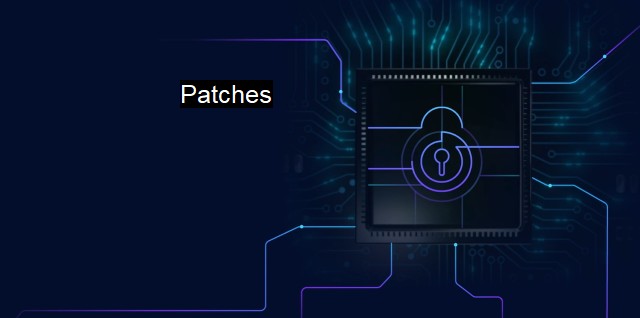What are Patches?
The Importance of "Patches": Upgrading Cybersecurity to Protect Against Threats and Vulnerabilities
Patches are a substantial component of cybersecurity, primarily used to correct vulnerabilities within software or programs. They are selective sets of data designed to update or revise software for different reasons, usually to combat susceptibilities that can be taken advantage of by cybercriminals. Imagine your software to be a castle and the hacker as the invader. patches would be the repairs you make to your walls, gates, and defenses to prevent the intruders from penetrating your protections.A software vulnerability refers to a flaw, error, bug, or weakness in a software program or system that cybercriminals could exploit to carry out various activities, like malicious attacks or unauthorized data access. When a vulnerability is discovered, software developers act swiftly to develop and release patches designed to address these vulnerabilities and strengthen the software's defense mechanisms. They are like quick repairs that cover the hole in a dinghy so that hackers don't sink your boat.
The patches can be likened to vaccinations in that they are preventative measures. Like vaccines administered to prevent diseases, an applied patch protects against potential cyber threats. They are critical for enhancing cybersecurity and protecting against cyberattacks, as unpatched software presents a significant risk for users and businesses across industries worldwide.
Users often underestimate the importance of keeping their systems updated or patched due to seeming inconvenience or lack of understanding. Patch 'fatigue' among users sometimes leads to complacency, leaving computer systems at risk. Some perceive patches as a burdensome chore, neglecting that it's a necessary facet of cybersecurity maintenance. Still, these minimally invasive updates are imperative to keeping data safe.
To facilitate the patching process, many software companies automatically remind all end-users to apply patches or updates through pop-up messages, push notifications, or email alerts. Some companies have even enabled automated patches to ensure protection against potential threats. But it is important to be cautious here; some notifications may unfortunately be a sprawling pitfall, cleverly made virus, or malicious software camouflaging as updates. Always verify the source before installing any patches or updates.
In the antivirus and anti-malware software world, patches serve similar purposes. Almost every day, hackers develop new types of malware or viruses, causing increasing mayhem in the digital world. To combat this evolving threat, antivirus companies regularly survey the threat landscape and patch their software, allowing it to identify and neutralize newly created malware or viruses. Statistically speaking, a large proportion of successful cyberattacks are conducted on out-of-date, unpatched software.
To sum up, patches are crucial elements of maintaining a high level of cybersecurity. Their essence validates an old yet relevant saying: prevention is better than cure. Just as we would prefer to prevent illnesses rather than cure them, it is more beneficial, more convenient, and decidedly more cost-effective to prevent cyberattacks before they occur rather than dealing with their after-effects. It can be easy to overlook patch implementation, but it remains a consistent, ongoing necessity as part of a solid cybersecurity culture - prioritizing security and maintaining resilience in the ever-changing landscape of cyber threats. patches function in the pursuit of perfecting safety mechanisms that are in place, ensuring primarily that the safety barriers are continuously hardened against any form of emerging vulnerability.

Patches FAQs
What are patches in the context of cybersecurity and antivirus?
In cybersecurity and antivirus, patches are updates or fixes that are released to address vulnerabilities or bugs in software or operating systems. These updates provide increased security and improve the performance of the software.How do patches help improve cybersecurity and antivirus protection?
Patches help to improve cybersecurity and antivirus protection by fixing vulnerabilities in software that can be exploited by hackers or malware. By keeping software up to date with the latest security patches, users can reduce the risk of becoming a victim of cyber attacks.What is the process for installing a patch for antivirus software?
The process for installing a patch for antivirus software usually involves downloading the patch from the vendor's website, saving it to the computer, and then running the installation program. Some antivirus software may automatically check for updates and download and install patches automatically. It is important to always ensure that software is up to date with the latest patches to ensure adequate protection against cyber threats.What should I do if a patch causes issues or conflicts with my system?
If a patch causes issues or conflicts with your system, you should immediately contact the vendor's technical support team for assistance. They will assess the issue and provide guidance on how to best resolve the problem. In some cases, the vendor may release a new patch to address the issue or provide a workaround. It is important to always keep software up to date, but also to be aware of potential conflicts or issues that may arise.| | A | | | B | | | C | | | D | | | E | | | F | | | G | | | H | | | I | | | J | | | K | | | L | | | M | |
| | N | | | O | | | P | | | Q | | | R | | | S | | | T | | | U | | | V | | | W | | | X | | | Y | | | Z | |
| | 1 | | | 2 | | | 3 | | | 4 | | | 7 | | | 8 | | |||||||